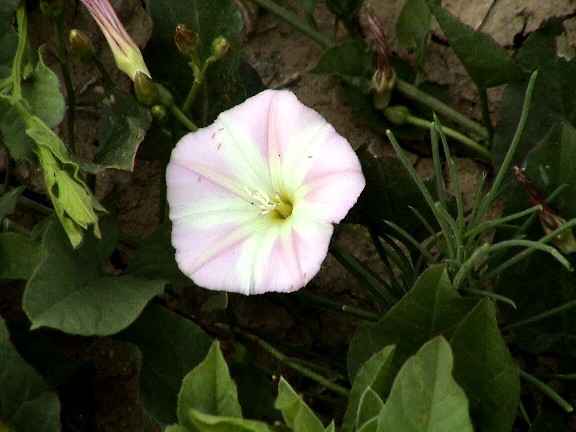Field Bindweed (Convolvulus arvensis)

Identification
Field bindweed is a creeping perennial from Europe. A member of the Morningglory family, it reproduces not only by seed but by its horizontal roots as well. The root system and rhizomes are extensive, white in color, and fleshy.
Field bindweed stems are prostrate (grows low to the ground) and twining, smooth, and can grow up to 6 feet long. Leaves are 1 to 2 inches long and are distinguishable by their arrow-head shape.
Flowers are rounded and white to pale pink in color. The flowers are about ¾ to 1 inch broad. Seeds are pearl-shaped, dull, and brown in color. One plant can produce anywhere between 30 and 200 seeds, the number produced is variable on environmental conditions.
Seed viability can be retained over a period of at least 30 to 40 years in the soil. Field bindweed is well adapted to Adams County and is widespread. It is extensively found in pastures, lawns, gardens, cultivated fields, waste areas, roadsides, and rangelands. Field bindweed thrives on disturbance, especially cultivation and/or overgrazing.
Field bindweed is designated as a “List C” species on the Colorado Noxious Weed Act. It is required to be either eradicated, contained, or suppressed depending on the local jurisdictions managing this species.
Control
Field bindweed is an extremely difficult noxious weed to control because, in part, of its taproot that may go 20 feet deep into the soil, and which repeatedly gives rise to numerous long rhizomes.
Chemical
Herbicides labeled for use on field bindweed and found to be effective are: picloram (Tordon 22K), dicamba (Banvel), glyphosate (Roundup, Rodeo), and 2,4-D. Picloram and dicamba can injure trees. Effective control can take many years with some herbicide use strategies. Proper timing of application is critical, during late spring, or just after full-bloom, and early fall are ideal opportunities to apply picloram and 2,4-D.
Mechanical
Mechanical control of field bindweed is difficult because of its low growth habit. Mowing generally has little or no effect. Hoeing or grubbing are more effective. Cultivation at intervals of 10 to 14 days can be effective, but 2 or more growing seasons of diligent effort are needed to achieve stand reduction. Cultivation intervals must continuously be maintained. Cultivation can spread bindweed rhizomes to noninfested sites via dragging, or from being transported on the cultivation equipment.
Biological
Biological control of field bindweed is difficult, at best. No insects are available that effectively control this weed. Livestock will graze bindweed as a nutritious feed; horses, however, can develop intestinal problems when eating primarily bindweed. Because of its low growth habit, however, bindweed tends not to be grazed radically enough to cause necessary plant stress. If it is, often the site is overgrazed, which is not desirable and tends to favor bindweed proliferation. Seed production may not be prevented, despite efforts through grazing.
Cultural
Cultural control methods tend to work poorly towards controlling bindweed. A productive, aggressive grass stand will tend to slow the spread of bindweed, and to deter the establishment of new infestations. But bindweed will survive and spread, even in a bluegrass lawn.



